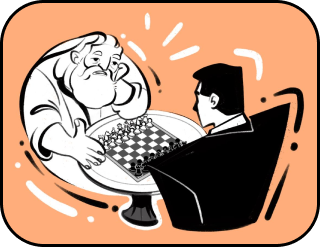Category: Cognitive technologies
Sacred geometry: lines, symbols and timeless knowledge
“Chaos is merely order waiting to be deciphered”
José Saramago
We all went to school once, where we were given a ruler and a pencil. We were taught to draw perfect circles, trace impeccable squares, and construct sharp-angled triangles. We learned to calculate area, find sines and cosines, and solve problems, but they forgot to tell us about the most important thing—the fundamental knowledge of geometry.
Since ancient times, people have tried to bring the chaotic world into form, to find order and harmony within it. They looked at the world and saw a hidden blueprint, written in the language of geometry. They sought the primary source of form, the very idea of order. And their search led to discoveries that turned out to be not mysticism, but a strict instruction manual for the universe, written long before the first calculators appeared.
Today, we admire complex formulas and the power of colliders. We marvel at scientific discoveries and delight in elegant blueprints, forgetting that all the fundamental answers of the universe lie not in the future, but in the past—encoded in the perfect forms of Platonic solids, the divine proportions of the Golden Ratio, the enigmatic magic squares, and mandalas.
This article is not about magic. We invite you to look anew at familiar and lesser-known symbols, lines, and signs: not as conventional science, but as the most ancient universal language through which the universe itself speaks to us. Let us remember what it is like to be students, take a reliable ballpoint pen, open notebooks for knowledge—not for formulas—and try to start from the very beginning.
The Sephirotic Tree of Life
Ten little circles and some lines. The figure itself looks like just another psychedelic print for a hipster T-shirt. In reality, the Sephirotic Tree of Life is the genuine instruction manual for the universe. How did that happen? No one really understands.
Fourth millennium BC. People are toiling in the fields, dying from dirty water, lightning strikes setting their shacks on fire. And what are they doing at this moment? Inventing the wheel? The steam engine? Antibiotics? No, my friend. They are drawing the brand book of creation. Because when surrounded by utter darkness, the only way not to lose your mind is to discover that this chaos has a designer. And apparently, this designer is a great enthusiast of geometry.
See this bold circle at the bottom? That’s you. See it? This is Malkuth—your starting point. It smells of old carpet, stress, the fear of being late for work, and laundry detergent. At this point, you’re paying your mortgage and scrolling through your social media feed, feeling like an insect. Welcome home.
See this vertical line? This is your Pillar of Consciousness, your personal elevator to the heavens. On the right is the department of mercy, teaching you to love. On the left is the department of consciousness, explaining what is worthy of love and what is not. This is what the choice between creation and destruction looks like, the choice between relying on unrequited goodness or glorifying pragmatism. The three pillars create balance, and if you remove even one of them, the entire structure will collapse.
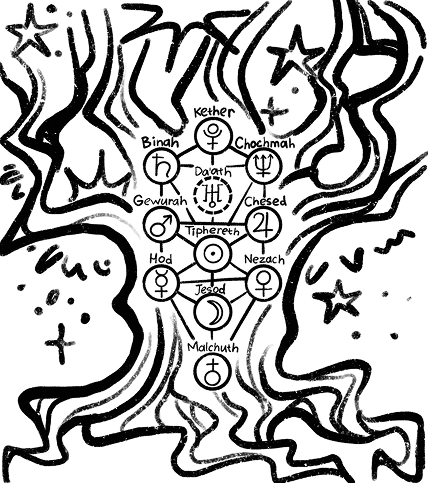
And now for the best part—twenty-two channels of internal communication, a full twenty-two ways to know yourself. Horizontal paths are internal battles between the cold, calculating analyst and the fiery creator, the tension between your own “I want” and others’ “you must.” Vertical paths are the elevators through which force flows: from top to bottom flows a stream of insights, passing through internal filters; from bottom to upward pass the stages of personal ascent from understanding to wisdom. Diagonal paths are like hacking the system, when the habitual “I can’t do this” suddenly does a backflip, setting you on a path of new achievements. That very “Flaming Sword”—a short circuit between logic and madness. It’s painful, frightening, but afterward, you can spend a year telling your friends at the bar how you dramatically changed your life.
And you know what the main trick is? This knowledge was concealed for centuries, with the clear understanding that an unprepared mind might not withstand looking into the Tree too early. The inhabitants of Mesopotamia, who created this portal, were not limited eccentrics; they were the first IT specialists of the universe. They knew that looking at the Tree of Life was like looking at the source code of reality. And this code is written in the language of sacred geometry: mirrored pillars, a perfect vertical, and lines that connect everything into one. The eye is drawn to this structure because we ourselves are built from the same blueprint.
You think “sacred geometry” is a science about compasses and numbers? No. It points to the fact that your own internal hive is itself a geometric object. Your neural connections are those very 22 paths. You are a living, breathing mathematical formula—beautiful, ideal, albeit slightly worn down by daily life. You are a co-creator of the universe. You are a living, breathing, hungover golden spiral.
If the entire universe is just a pattern, why not draw your own graffiti over it? After all, in the end, the only one who can unlock this interface is you. The passcode is your primordial desire.
THE MAGIC SQUARE
The magic square is the world’s very first calculator for cheating reality. The first pill in history that humanity slipped to God Himself, to make Him admit that order exists.
The essence? Absurdly simple: you take a grid and fill it with numbers so that the sums in every row, every column, and both diagonals are equal. That’s it. You’ve just created a mathematical narcotic, a perfect formula that gives the universe an orgasm.
The most famous magic square is the 3×3 Square of Saturn. It looks like a boring little grid any schoolkid could draw on a napkin, but try to play against it just once—you’ll lose. Because the universe plays by these rules, not yours.
4 | 9 | 2
———
3 | 5 | 7
———
8 | 1 | 6
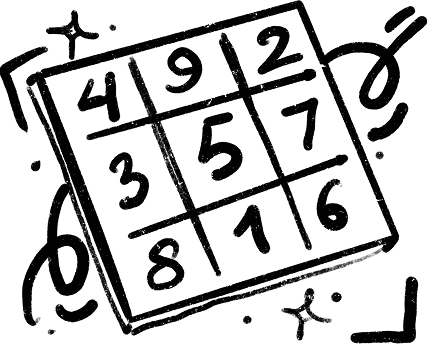
No matter where we start counting, the sum will always be 15. It will always be 15. You can wake up drunk on a Monday, you can lose your job, your girl, your mind, but in the magic square, the sum will still be 15.
There’s no magic here. Instead, there is perfect order and absolute, total, flawless control over chaos. People in the 1st millennium BC didn’t beg the gods for help; they showed them this mathematical decree and said: “See? This is how it should be. Now make my life like this—ordered vertically, horizontally, and along all diagonals, so that everything adds up to the perfect sum.”
This square is symmetrical to its very core, but it’s not about the numbers. It’s about balance. About the fact that any movement in one direction must be compensated by a movement in the other. The magic square shows you that nothing in the world changes because you lost or gained something. But you futilely try to prove the opposite.
And this is where the magic begins.
16 | 3 | 2 | 13
——————-
5 | 10 | 11 | 8
——————-
9 | 6 | 7 | 12
——————-
4 | 15 | 14 | 1
If you look at this square long enough, it will start to sound. Each column will become a rhythmic pattern, constantly repeating: loud, quiet, quiet, loud.
And this rhythm is perfectly symmetrical, it’s looped. A pounding, ceaseless beat to which everything dances: from the motion of planets to the beating of a heart. And the people who lived centuries before us knew this. They felt the rhythm: four beats, nine beats, two beats. Three steps forward, five in place, seven turns, repeated over and over. An ornament on clothing or pottery, where the pattern repeats at certain intervals—that, too, is a visualization of the magic square.
All rituals are just track mixing—a human way to inscribe oneself into the universal beat of existence, an attempt to synchronize with it.
People back then understood: to make the world work for you, you don’t need to break it. You need to find its rhythm, to become “one of us” in the sacred performance of the Universe. The magic square is that very backstage pass.
And when you today draw, count out, tap out, play out, depict the magic square, you are doing the very same thing—you are showing all the laws of physics what the ideal world should look like. And in that moment, you cease to be a supplicant, because you become the architect. Even if it’s just on paper.
Even now, you can tell the Universe: “I know you are orderly. Now come on, make all circumstances fit my blueprint.”
The Flower of Life
Once upon a time, there was a certain… entity. Well, let’s call it the Universe. And it had a task: to create everything from nothing. No startup capital, no Scrum methodology courses, no clear technical assignment from higher management—just void and infinity to work with.
It could have, of course, hired a contractor or launched a crowdfunding campaign. But the Universe acted like any sensible fellow: it found some perfectly round rings in a junkyard and decided they would do just fine.
It pressed one circle against another without any particular intent, and two identical circles formed a figure of strict geometry—the “Vesica Piscis,” the first node of nothingness that could be filled with something. And then it took off.
The Universe stamped out these circles one after another, layering them not out of genius, but out of sheer stubbornness. And something strange happened—the neat circles began folding into patterns on their own: perfect hexagons, lattices, and complex chains. These patterns emerged by themselves, like cracks on an old wall.
The result was the very Flower of Life—the outcome of stubbornly replicating one simple action.
And you know the main secret? This pattern doesn’t aspire to beauty; it illustrates that chaos is merely a disassembled constructor. And any constructor comes with instructions, written in the language of intersecting circles and equal radii.
This is what the algorithm looks like—the one that assembles your own life from identical days, problems, and coincidences. One day overlaps another, one problem consumes the next, and you become a new version of yourself, assembled according to the same blueprint as everything else in this world.
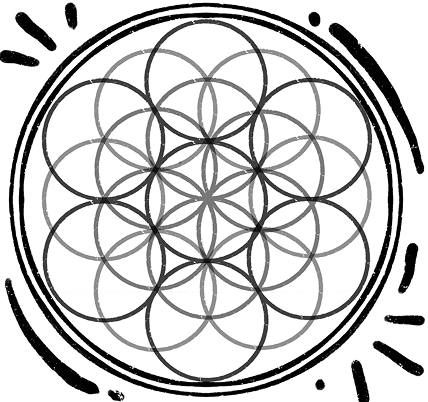
This knowledge brings the understanding that your personal chaos is not a system error, but rather a preparatory stage—disassembly before assembly. And if the Universe managed to build a perfectly functioning system from such a simple action, then you, with your 300 thousand and microloans, can certainly succeed too.
All that’s left is to stop searching for complicated paths and start placing the spheres in the right points. If the Universe had a logo, this is exactly what it would look like.
Platonic Solids
It’s simpler than it seems. Even too simple. Behind the entire diversity of the Universe, from a crack in the asphalt to the structure of the cosmos, lies a boring, almost totalitarian order—five shapes. Just five: the tetrahedron, cube, octahedron, dodecahedron, icosahedron. And there is nothing else, not because we haven’t thought of it, but because mathematics doesn’t allow it.
These figures are called Platonic because it was the Ancient Greek philosopher who articulated the verdict that geometry passed on the world.
Platonic solids have no flaw: all their faces, all their angles, all their edges are absolutely identical, which makes them the last Mohicans of perfection in a world that long ago made peace with curvature. Their anomaly is that they are everywhere. The crystal lattice of a diamond is a cube. The poliovirus is an icosahedron. A methane molecule arranges itself into a tetrahedron. Even soap bubbles, as they pop, form the same regular polyhedra. There’s nowhere to run. We’re stuck.
It all boils down to energy, or rather, to its sacred principle: for maximum stability, one must expend the least effort. Everything—from an atom to a galaxy—is impossibly lazy, so it seeks the path of least resistance, a way to spend less energy, to assume the most comfortable and stable position. Atoms are shaken, spun by thermal energy, and the only way to survive is to latch onto each other as firmly as possible to conserve energy.
Your drive for order in the kitchen, for a strict daily routine, for clear business processes—this is the deep, atomic need to assemble into a perfect crystal lattice and find peace. A person seeks harmony because they are physically compelled to seek it. Want to be stable? Assemble into a cube. Want to be streamlined? Assemble into an icosahedron. There are no other options.
These sacred figures don’t know geometry, just as you don’t know it, but they are all forced to obey the principle of minimum energy, and this is the Universe’s purest physical experiment in optimization.
The Platonic solids don’t call us to the world of the spiritual; on the contrary, they bring us down from the heavens to earth and remind us that complexity is an illusion we create ourselves to justify our own fear of the simple and merciless rules of the game. The rules have long been known. There are just five of them.
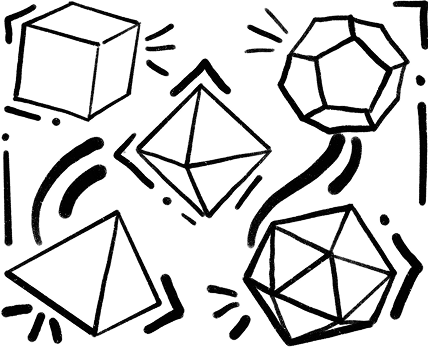
Mandala
Center, circle, symmetry. The world’s first spell, based on geometry. When ancient humans ran out of words, prayers, and strength, they turned to order and pleaded for symmetry.
In the depths of our consciousness exists a highly complex organization—a kind of headquarters called the “Psyche,” where countless processes occur every day: some algorithms are responsible for ensuring you don’t stick your finger in a socket, others for making you cry at an old song, and yet others simply steal bolts in the storeroom.
But sometimes the irreparable happens—severe stress, deep trauma, an irreplaceable loss—and then the small world within the headquarters collapses: neural wires snap, self-control systems fail, chaos floods the departments, and the chief executive—our consciousness—freezes, losing the ability to act.
It is precisely at such a moment that the built-in emergency protocol is activated, a protocol with only one, most fundamental blueprint for recovery: center, circle, symmetry.
The Swiss psychologist Carl Jung was the first to notice this phenomenon: his patients, undergoing severe crises, would spontaneously, without any instruction, start drawing concentric circles on paper, filled with lines and patterns. Jung concluded that within each of us lies an ancient, cognitive script for self-restoration.
Prehistoric labyrinths, shamanic drums, and the stained-glass windows of Gothic cathedrals—all are historical versions of the same internal software. The stone spiral on the Solovetsky Islands is a mandala manifested by the body. A person who walked through it performed a rite of rebirth and returned to the familiar world with an updated map of reality. A shaman would create a rhythmic pattern on his drum, mentally visualizing a mandala in his mind so as not to get lost in the abyss of trance and to recover what was lost.
Today, we entrust the creation of such sacred patterns to artificial intelligence. A neural network, given a prompt, generates a flawless mandala: a mathematically precise circle, impeccable symmetry, a composition without a single random line.
But it is in this flawlessness that the key difference lies. The mandala that was born for centuries in the silence of monastic cells, in the trance of shamans, in the agonies of a tormented soul, was a cast of an internal battle. It served as an act of overcoming, a geometric embodiment of experiences seeking an outlet in pattern. The neural network does not know this pain. It has no idea what it means to have the ground give way beneath your feet: it has never been denied love, never been betrayed by friends. The algorithm lacks that dark, living, painful experience from which an authentic mandala is born.
A true mandala is a scar healed into a perfect form, a testament to the struggle with the inner chaos that threatened to destroy everything. Its profound philosophy is that order and chaos are not enemies; they are eternal neighbors forced to share the same space. Chaos breaks down walls, and order draws patterns on the surviving wallpaper from the remaining fragments. The mandala is precisely such a pattern, born from catastrophe. Not in spite of it, but because of it. A crutch that the psyche finds for itself to avoid final disintegration.
And the next time your hand starts spontaneously drawing circles in your notebook during a boring lecture—don’t ignore that impulse. Perhaps, it is your internal system trying to repair itself through an interface whose age is measured in millennia.
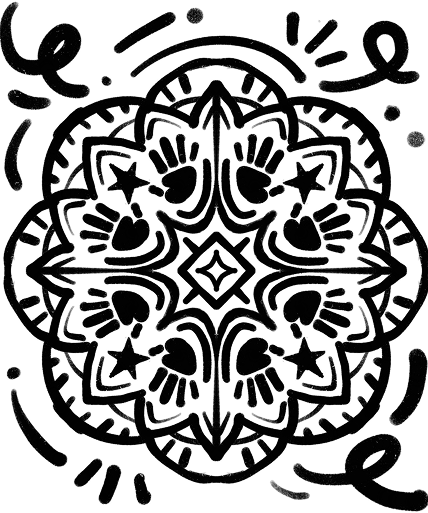
The Pentagram
The ultimate horror icon of the millennium. An astonishing story of how the same geometric design has, for centuries, signified divine protection, mathematical perfection, occult wisdom, and satanic evil. The history of this symbol is a history of how people interpret signs.
Originally, the pentagram was merely a geometric phenomenon of perfection, the embodiment of the ideal proportion—in a correctly drawn pentagram, every segment is in the golden ratio to its adjacent segment. That is, the ratios of the lengths of the pentagon’s sides to the sides of the star, and the pentagon’s diagonals to its sides, constantly give us the same number, φ ≈ 1.618.
This is where the mysticism begins.
Ancient scholars saw in this flawlessness proof that the universe is based on perfect numerical laws, and the pentagram is their key or map.
The pentagram was almost universally a positive, protective amulet: it served as a secret identifying symbol and a sign of health. Its five points symbolized the five elements: Fire, Water, Air, Earth, and Spirit (or Idea).
In Mesopotamia, kings were branded with the pentagram. Jews associated it with the Pentateuch of Moses—the world’s first sacred FAQ. Early Christians saw in its five rays the five wounds of Christ—a harsh but honest arithmetic of salvation. And in the Middle Ages, the pentagram was plastered on armor and house doors as the most reliable antivirus against vampires, demons, and other unclean spirits.
Legends attributed a magical ring with a pentagram to King Solomon himself. Not only did the king control demons and jinn with such a ring, but thanks to this device with the symbol of perfection, he also built his mega-projects.
And then they arrived: the 19th century and the French occultist Éliphas Lévi. Lévi took the pentagram and turned it on its head. Thus appeared the famous, brilliant division: if the pentagram is positioned with one point upward, it means Spirit reigns over Matter. If the pentagram stands with two points upward (one point down), it means Matter is clubbing Spirit over the head. Rebellion against the system, inversion, and the Goat of Baphomet.
It was the PR move of the century. A symbol that had served good for centuries was, in one fell swoop, branded an outcast.
But the real theater of the absurd was staged in 1966 by one Anton LaVey. He founded the Church of Satan and adopted the inverted pentagram with a goat’s head inside. This was now a conscious trolling of traditional values. Then came the gothic aesthetic, joined by the era of heavy metal and Hollywood horror films, and it began. The pentagram became a visual meme for absolute evil.
For centuries, people used this symbol to fence themselves off from chaos. Occultists used it to tame that chaos. Hollywood used it to sell that chaos for money.
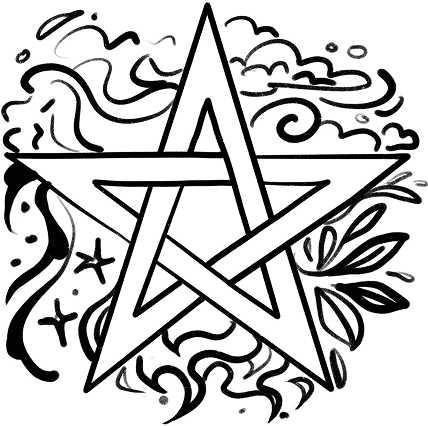
Any symbol is a blank canvas on which humanity paints its brightest hopes and darkest nightmares, and the pentagram is a perfect example of how meanings adhere to symbols. Its “evil” is far from innate; it’s acquired, ours, human. We ourselves took a benchmark of harmony and distorted it beyond recognition simply because we felt like it. And in that, perhaps, lies its main magic.
Sacred Geometry
I’ve always hated chaos. What could be worse than socks scattered on the floor, endless notifications from dubious companies on your phone, the obsessive chatter of thoughts in your head, the illogical actions of friends and subordinates? It seemed to me that the desire to put everything in order was a desperate attempt to keep everything under control. A sign of human weakness, not strength.
And that was my biggest mistake, because the desire to sort everything into neat boxes is an attempt to hear that very low-frequency hum on which the Universe rests. The very rhythm beaten by the heart of the galaxy and tapped out by the quarks in the atoms of my kettle.
Ancient people didn’t want to calculate. They wanted to understand. And they did understand. They poked sticks in the mud and drew the same spirals that our supercomputers output today. They didn’t know the number “pi,” but they inscribed a circle within a square with an accuracy that would make a modern architect’s brain cramp.
Sacred geometry is the knowledge of a code that is accessible to everyone.
The understanding that your scattered life, your anxieties and ecstasies, are simply variations on the theme of the same pattern. That your divorce follows the same laws as the collapse of stars. That death and birth are just different phases of one geometric transformation.
And the biggest revelation is that this code is idiotically simple. To the point of tears, to the point of frenzy, to the desire to smash your head against a wall upon realizing all this divine and absurd simplicity.
We look for complex answers, while universes, galaxies, and soap bubbles simply follow the same recipe, like a salaried pastry chef who has been baking the same croissants for ten billion years.
Everything has already been invented. Everything has already been drawn. All that’s left for us is to recognize the patterns—in the cracks in the asphalt, in the pulsation of a screen, in the curve of our own destiny.
This lesson is over. By the way, you get an A.
Linear-arithmetic synthesis is based on sound formation. We’ve synthesized the perfect formula of facts and interest.
Thank you!



